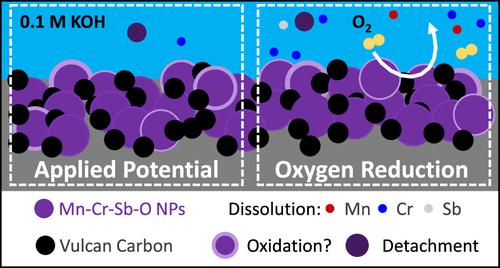当前位置:
X-MOL 学术
›
J. Am. Chem. Soc.
›
论文详情
Our official English website, www.x-mol.net, welcomes your feedback! (Note: you will need to create a separate account there.)
Understanding the Stability of Manganese Chromium Antimonate Electrocatalysts through Multimodal In Situ and Operando Measurements
Journal of the American Chemical Society ( IF 15.0 ) Pub Date : 2022-12-01 , DOI: 10.1021/jacs.2c08600 Melissa E Kreider 1, 2 , Gaurav A Kamat 1, 2 , José A Zamora Zeledón 1, 2 , Lingze Wei 1, 2 , Dimosthenis Sokaras 3 , Alessandro Gallo 2 , Michaela Burke Stevens 2 , Thomas F Jaramillo 1, 2
Journal of the American Chemical Society ( IF 15.0 ) Pub Date : 2022-12-01 , DOI: 10.1021/jacs.2c08600 Melissa E Kreider 1, 2 , Gaurav A Kamat 1, 2 , José A Zamora Zeledón 1, 2 , Lingze Wei 1, 2 , Dimosthenis Sokaras 3 , Alessandro Gallo 2 , Michaela Burke Stevens 2 , Thomas F Jaramillo 1, 2
Affiliation

|
Improving electrocatalyst stability is critical for the development of electrocatalytic devices. Herein, we utilize an on-line electrochemical flow cell coupled with an inductively coupled plasma-mass spectrometer (ICP-MS) to characterize the impact of composition and reactant gas on the multielement dissolution of Mn(−Cr)–Sb–O electrocatalysts. Compared to Mn2O3 and Cr2O3 oxides, the antimonate framework stabilizes Mn at OER potentials and Cr at both ORR and OER potentials. Furthermore, dissolution of Mn and Cr from Mn(−Cr) −Sb–O is driven by the ORR reaction rate, with minimal dissolution under N2. We observe preferential dissolution of Cr totaling 13% over 10 min at 0.3, 0.6, and 0.9 V vs RHE, with only 1.5% loss of Mn, indicating an enrichment of Mn at the surface of the particles. Despite this asymmetric dissolution, operando X-ray absorption spectroscopy (XAS) showed no measurable changes in the Mn K-edge at comparable potentials. This could suggest that modification to the Mn oxidation state and/or phase in the surface layer is too small or that the layer is too thin to be measured with the bulk XAS measurement. Lastly, on-line ICP-MS was used to assess the effects of applied potential, scan rate, and current on Mn–Cr–Sb–O during cyclic voltammetry and accelerated stress tests. With this deeper understanding of the interplay between oxygen reduction and dissolution, testing procedures were identified to maximize both activity and stability. This work highlights the use of multimodal in situ characterization techniques in tandem to build a more complete model of stability and develop protocols for optimizing catalyst performance.
中文翻译:

通过多模式原位和操作测量了解锰酸铬铬电催化剂的稳定性
提高电催化剂的稳定性对于电催化装置的发展至关重要。在此,我们利用在线电化学流通池与电感耦合等离子体质谱仪 (ICP-MS) 相结合来表征成分和反应气体对 Mn(−Cr)–Sb–O 电催化剂多元素溶解的影响。与 Mn 2 O 3和 Cr 2 O 3氧化物相比,锑酸盐骨架在 OER 电位下稳定 Mn,在 ORR 和 OER 电位下稳定 Cr。此外,Mn(−Cr) −Sb–O 中 Mn 和 Cr 的溶解是由 ORR 反应速率驱动的,在 N 2下溶解最小. 我们观察到与 RHE 相比,在 0.3、0.6 和 0.9 V 下,Cr 在 10 分钟内优先溶解总计 13%,而 Mn 仅损失 1.5%,表明 Mn 在颗粒表面富集。尽管存在这种不对称溶解,原位 X 射线吸收光谱 (XAS) 显示在可比较的电位下 Mn K 边缘没有可测量的变化。这可能表明对表面层中 Mn 氧化态和/或相的修改太小,或者该层太薄而无法通过块状 XAS 测量进行测量。最后,在线 ICP-MS 用于评估循环伏安法和加速应力测试期间外加电位、扫描速率和电流对 Mn-Cr-Sb-O 的影响。随着对氧还原和溶解之间相互作用的更深入理解,确定了测试程序以最大限度地提高活性和稳定性。这项工作强调串联使用多模式原位表征技术来构建更完整的稳定性模型并开发优化催化剂性能的方案。
更新日期:2022-12-01
中文翻译:

通过多模式原位和操作测量了解锰酸铬铬电催化剂的稳定性
提高电催化剂的稳定性对于电催化装置的发展至关重要。在此,我们利用在线电化学流通池与电感耦合等离子体质谱仪 (ICP-MS) 相结合来表征成分和反应气体对 Mn(−Cr)–Sb–O 电催化剂多元素溶解的影响。与 Mn 2 O 3和 Cr 2 O 3氧化物相比,锑酸盐骨架在 OER 电位下稳定 Mn,在 ORR 和 OER 电位下稳定 Cr。此外,Mn(−Cr) −Sb–O 中 Mn 和 Cr 的溶解是由 ORR 反应速率驱动的,在 N 2下溶解最小. 我们观察到与 RHE 相比,在 0.3、0.6 和 0.9 V 下,Cr 在 10 分钟内优先溶解总计 13%,而 Mn 仅损失 1.5%,表明 Mn 在颗粒表面富集。尽管存在这种不对称溶解,原位 X 射线吸收光谱 (XAS) 显示在可比较的电位下 Mn K 边缘没有可测量的变化。这可能表明对表面层中 Mn 氧化态和/或相的修改太小,或者该层太薄而无法通过块状 XAS 测量进行测量。最后,在线 ICP-MS 用于评估循环伏安法和加速应力测试期间外加电位、扫描速率和电流对 Mn-Cr-Sb-O 的影响。随着对氧还原和溶解之间相互作用的更深入理解,确定了测试程序以最大限度地提高活性和稳定性。这项工作强调串联使用多模式原位表征技术来构建更完整的稳定性模型并开发优化催化剂性能的方案。



























 京公网安备 11010802027423号
京公网安备 11010802027423号